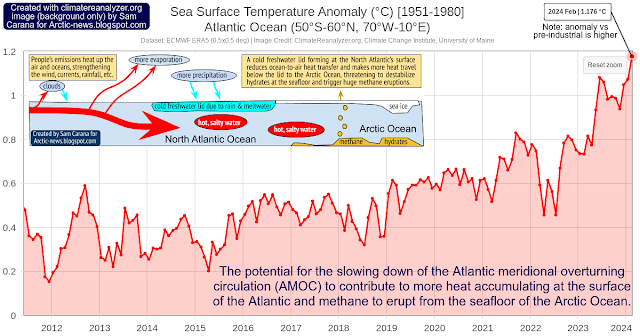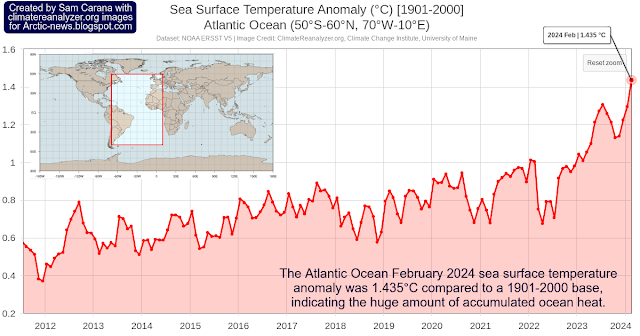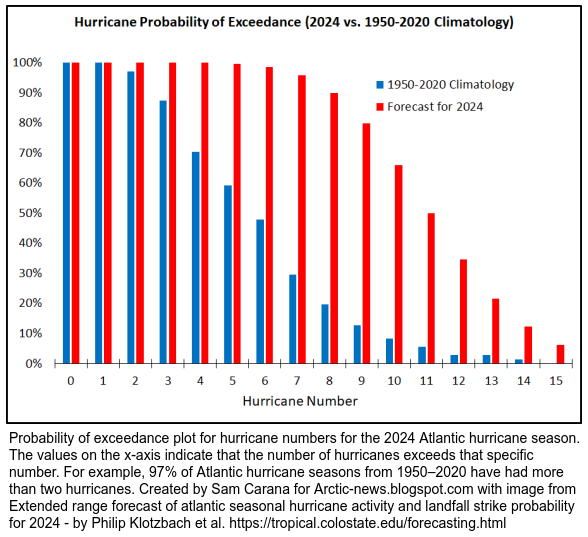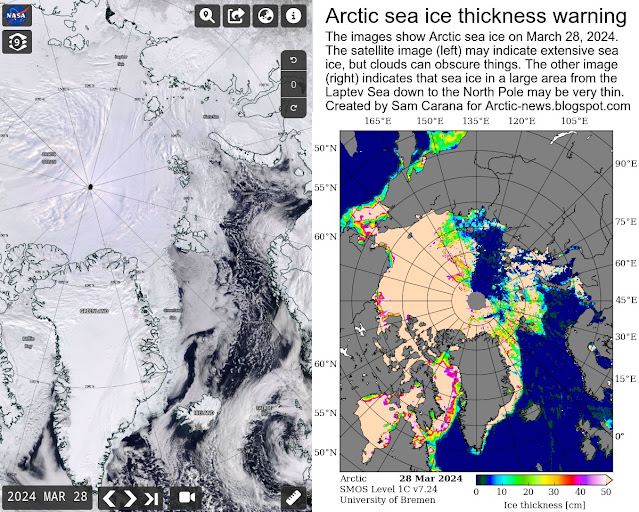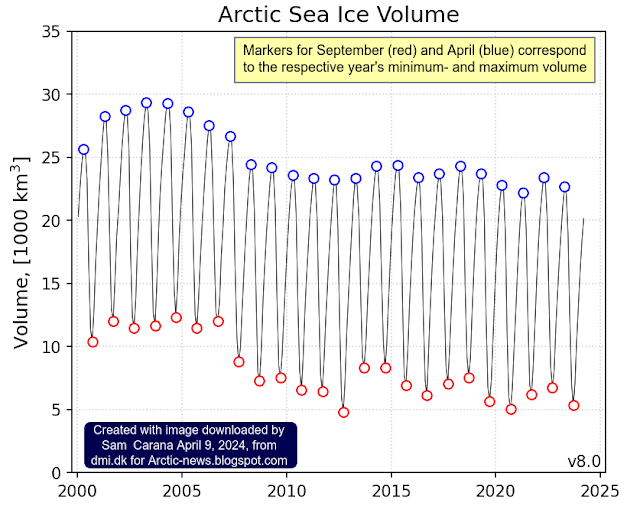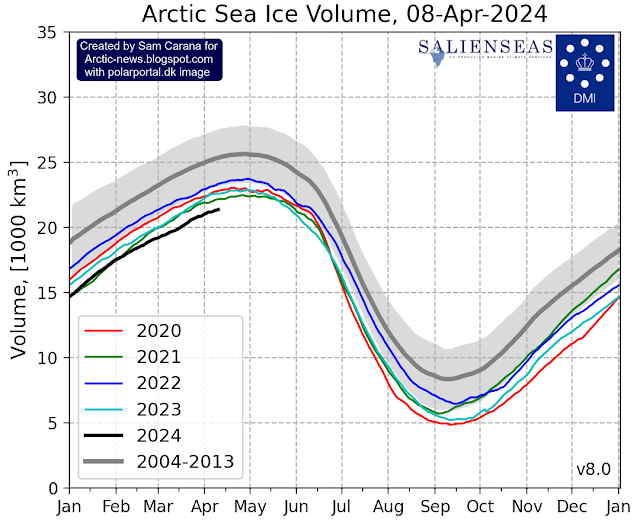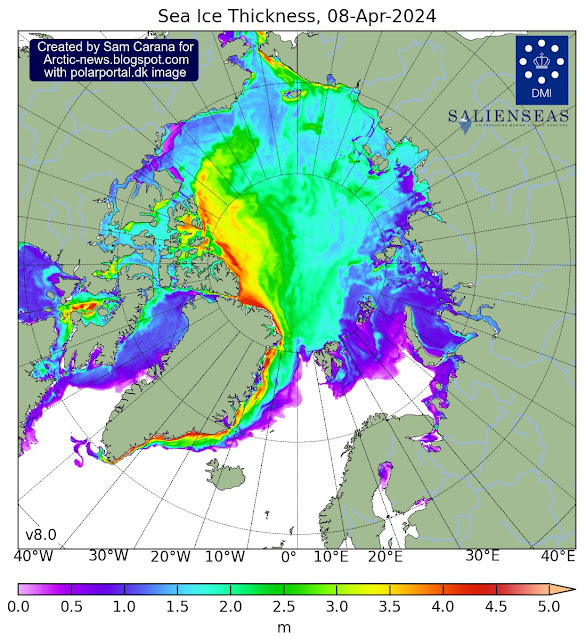While this may look to cause less ocean heat to reach the Arctic Ocean at the moment, the result is that a huge amount of ocean heat is accumulating in the North Atlantic that threatens to abruptly move into the Arctic Ocean. The danger is that an influx of ocean heat can cause large amounts of methane to erupt from the seafloor of the Arctic Ocean.
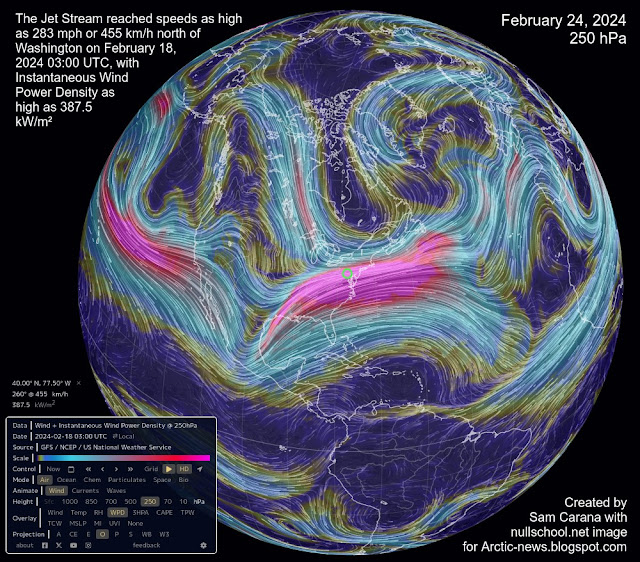 |
| From earlier post Blue Ocean Event 2024? |
A huge amount of ocean heat is accumulating in the North Atlantic and threatens to abruptly move into the Arctic Ocean. The danger is that, due to strong wind along the path of the Gulf Stream, huge amounts of ocean heat will abruptly get pushed into the Arctic Ocean, with the influx of ocean heat causing destabilization of hydrates contained in sediments at the seafloor of the Arctic Ocean, resulting in eruptions of huge amounts of methane.
The compilation image below shows Arctic sea ice on March 28, 2024. The satellite image (left) may indicate extensive sea ice, but clouds can obscure things. The other image (right) indicates that sea ice in a large area from the Laptev Sea down to the North Pole may be very thin.
The images above and below show that Arctic sea ice volume has recently been the lowest on record for the time of year.
Given that Arctic sea ice currently is still relatively extensive, this low volume indicates that sea ice is indeed very thin, which must be caused by ocean heat melting sea ice from below, since little or no sunshine is yet reaching the Arctic at the moment and air temperatures are still far below freezing point, so where ocean heat may be melting sea ice away from below, a thin layer of ice will quickly be reestablished at the surface.
This situation looks set to dramatically change over the next few months, as air temperatures will rise and as more ocean heat will reach the Arctic Ocean. Moreover, as illustrated by the map below, much of the thicker sea ice is located off the east coast of Greenland. This sea ice and the purple-colored sea ice can be expected to melt away quickly with the upcoming rise in temperatures over the next few months.
Climate Emergency Declaration
The situation is dire and the precautionary principle calls for rapid, comprehensive and effective action to reduce the damage and to improve the situation, as described in this 2022 post, where needed in combination with a Climate Emergency Declaration, as discussed at this group.
• Pre-industrial
https://arctic-news.blogspot.com/p/pre-industrial.html
• Cold freshwater lid on North Atlantic
https://arctic-news.blogspot.com/p/cold-freshwater-lid-on-north-atlantic.html
• European summer weather linked to North Atlantic freshwater anomalies in preceding years – by Marilena Oltmanns et al.
https://wcd.copernicus.org/articles/5/109/2024/wcd-5-109-2024-discussion.html
discussed at facebook at:
https://www.facebook.com/groups/arcticnews/posts/10161330866254679
• Science Snippets: Arctic Sea Ice Affects European Summers, Marine Life, and All Life on Earth – by Guy McPherson
https://www.youtube.com/watch?v=X09vtWNDuDw
• nullschool
https://earth.nullschool.net
• Jet Stream
https://arctic-news.blogspot.com/p/jet-stream.html
• Extended range forecast of Atlantic seasonal hurricane activity and landfall strike probability for 2024 – by Philip Klotzbach et al.
https://tropical.colostate.edu/forecasting.html
https://www.facebook.com/groups/arcticnews/posts/10161346323759679
https://arctic-news.blogspot.com/2017/01/arctic-ocean-feedbacks.html
• NASA Worldview satellite images
https://worldview.earthdata.nasa.gov
• University of Bremen – Arctic sea ice
https://seaice.uni-bremen.de/start
• Danish Meteorological Institute – Arctic sea ice volume and thickness
• Climate Plan
https://arctic-news.blogspot.com/p/climateplan.html
• Climate Emergency Declaration
https://arctic-news.blogspot.com/p/climate-emergency-declaration.html

